6.3 Retrieval and Forgetting

Have you ever heard the saying “an elephant never forgets”? Granted, this might be somewhat of an overstatement, but as far as animals go, elephants do have fairly remarkable memories. Consider the story of two elephants who briefly worked together in the circus and then were separated for 23 years. When they reencountered one another at an elephant sanctuary in Tennessee, the two animals started to inspect each other’s trunk scars and “bellowed” in excitement: The long-lost friends had recognized one other (Ritchie, 2009, January 12)! An elephant’s memory—and yours, too—is only as good as its ability to retrieve stored memories. Let’s return to the World Memory Championships and examine the critical process of retrieval.
What Can you Retrieve?
LO 9 Illustrate how encoding specificity relates to retrieval cues.
Every event in the World Memory Championships begins with encoding data into the memory system and storing that information for later use. Contestants are presented with information—numbers, words, historic dates, and the like—and provided a certain amount of time to file it away in long-term memory. But no matter how much information they absorb, the contestants’ efforts are meaningless if they can’t retrieve it in the recall phase of the event.
Retrieval Cues and Priming
One of the most grueling events in the World Memory Championships is “One Hour Numbers,” a race to see who can memorize the greatest number of random digits in an hour. Contestants are given four sheets of paper, each containing 1,000 random digits, and 1 hour to cram as many as possible into their long-term memories. During the recall phase that follows, they get 2 hours to scrawl the correctly ordered numbers on blank sheets of paper. This is a backbreaker because there are no reminders, or retrieval cues, to help contestants locate the information in their long-term memory. Retrieval cues are stimuli that help you retrieve stored information that is difficult to access (Tulving & Osler, 1968). For example, let’s say you were trying to remember the name of the researcher who created the working memory model introduced earlier in the chapter. If we gave you the first letter of his last name, B, would that help you retrieve the information? If your mind jumped to “Baddeley” (the correct answer), then B served as your retrieval cue.
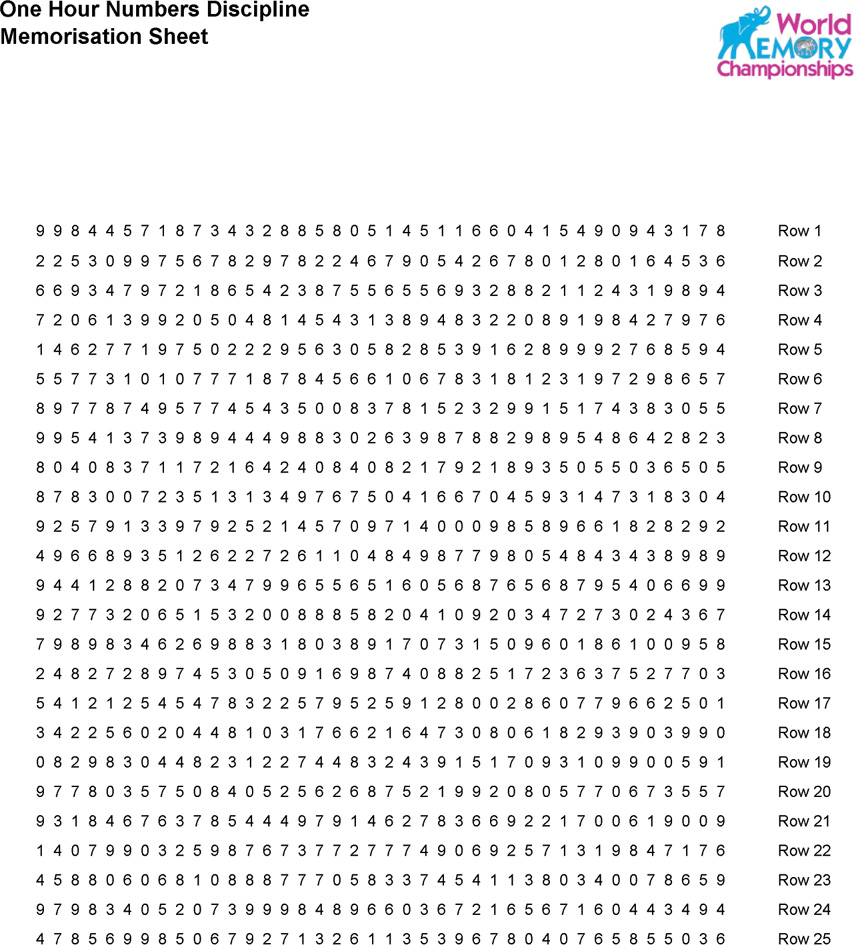
Even Clive Wearing, who could not remember what was happening from one moment to the next, showed evidence of using retrieval cues. For instance, Clive spent 7 years of his life at St. Mary’s Hospital in Paddington, England, yet had no conscious memory of living there. And, according to his wife Deborah, Clive was “completely devoid” of knowledge of his own location; the hospital name was not at all connected with his sense of location (D. Wearing, personal communication, June 25, 2013). But if Deborah prompted him with the words “St. Mary’s,” he would chime back, “Paddington,” oblivious to its connection (Wearing, 2005, p. 188). In this instance, the retrieval cue in Clive’s environment (the sound of the word “St. Mary’s”) was priming his memory of the hospital name. Priming is the process of awakening memories with the help of retrieval cues.
At this point, you may be wondering how priming can occur in a person with severe amnesia. Clive’s conscious, explicit memory is diminished, but his unconscious, implicit memory still functions. Just because he could not articulate, or “declare,” the name of the hospital does not mean that the previously known word combination had entirely vanished from his memory system.
Recall and Recognition
Now let’s return to the “One Hour Numbers” event of the World Memory Championships. This type of challenge relies on pure recall, the process of retrieving information held in long-term memory without the help of explicit retrieval cues. Recall is what you depend on when you answer fill-in-the-blank or short-answer essay questions on exams. Say you are given the following prompt: “Using a computer metaphor, what are the three processes involved in memory?” In this situation, you must come up with the answer from scratch: “The three processes are encoding, storage, and retrieval.”
Now let’s say you are faced with a multiple-choice question: “One proven way of retaining information is: (a) distributed practice, (b) massed practice, or (c) eidetic imagery.” Answering this question relies on recognition, the process of matching incoming data to information stored in long-term memory. Recognition is generally a lot easier than recall because the information is right before your eyes; you just have to identify it (Hey, I’ve seen that before). Recall, on the other hand, requires you to come up with information on your own. Most of us find it easier to recognize the correct answer from a list of possible answers in a multiple-choice question than to recall the same correct answer for a fill-in-the-blank question.
Serial Position Effect
Recall and recognition come into play outside of school as well. Just think about the last time someone asked you to pick up a list of items at the store. In order to find the requested items, you had to recognize them (There’s the ketchup), but even before that you had to recall them—a much harder task. The ability to recall items appearing in a list depends on where they fall in the list, a phenomenon psychologists call the serial position effect (Figure 6.8). When given a list of words to memorize, research participants are better able to remember items at the beginning of the list, which is known as the primacy effect, as well as items at the end, which is called the recency effect (Deese & Kaufman, 1957; Murdock, 1962).
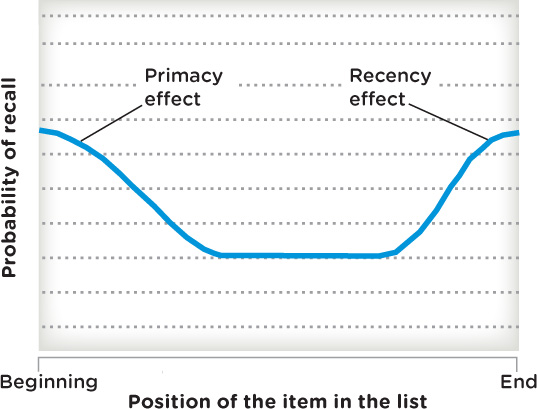
Imagine you are on your way to the store to buy supplies for a dinner party, but your cell phone battery is about to die. Your phone rings; it’s your housemate asking you to buy the following items: napkins, paper towels, dish soap, butter, laundry soap, paper plates, sparkling water, ice cream, plastic spoons, bread, pickles, and flowers. Without any way to write down this list, you are at the mercy of the serial position effect. In all likelihood, you will return home with napkins, paper towels, and a bottle of dish soap (due to the primacy effect), as well as bread, pickles, and flowers (due to the recency effect); the items in the middle will more likely be forgotten.
Now imagine you are a top executive at a television network, and one of your responsibilities is to decide which time slots advertisers should pay the most for—those at the beginning, middle, or end of a commercial break. One study looking at college students’ viewings of TV commercials found that the brand names they recalled best came from ads appearing at the beginning and end of breaks (Terry, 2005). The first ads were etched most deeply in students’ long-term memories because they had the most time to think about them (the primacy effect). The final ads, on the other hand, were easily recalled because they still lingered in short-term memory (the recency effect).
What do you think happened when the researchers allowed more time to pass, questioning students at the end of the program rather than immediately following commercial breaks? Memories of the first ads held strong (probably because they had been encoded in long-term memory), whereas those of the later ads faded (presumably because they had dropped out of short-term memory, never even transitioning to long-term storage). The solution to your dilemma is to charge big bucks for the first ads, because they will stick longest in the minds of viewers.
Context is Everything
When it comes to retrieving memories, context matters. Where were you when you encoded the information, and what was occurring around you? Researchers have found that environmental factors play a key role in determining how easily memories are retrieved.
In a classic study conducted by Godden and Baddeley (1975), participants learned lists of words under two conditions: while underwater (using scuba gear) and on dry land. They were then tested for recall in both conditions: If they learned the list underwater, they were tested underwater and on dry ground; if they learned the list on dry ground, they were tested on dry ground and underwater. The participants were better able to retrieve words when the learning and recall occurred in the same location (Figure 6.9). If they learned the words underwater, they had an easier time retrieving them underwater. The same was true for words learned on land. Here we have an example of context-dependent memory; memories are easier to access when the encoding and retrieval occur in similar contexts.
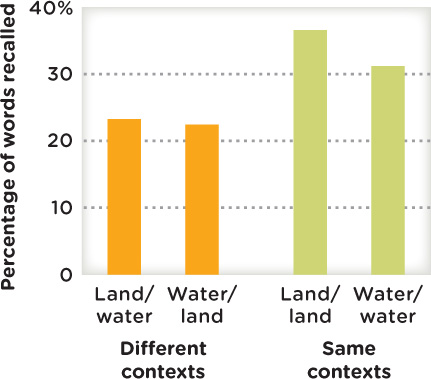
Context-dependent memory is part of a broader phenomenon conveyed by the encoding specificity principle, which states that memories are more easily recalled when the context and cues at the time of encoding are similar to those at the time of retrieval (Smith, Glenberg, & Bjork, 1978; Tulving & Thompson, 1973). There is even evidence that summoning a memory for an event reactivates the same brain areas that became excited during the event itself (Danker & Anderson, 2010).
This suggests that the activity in your brain at the time of encoding is similar to that at retrieval. In one study examining how odors and memories are linked, participants were asked to smell an odor (positive, negative, and neutral) at the same time they were presented with an image (animals, tools, vehicles). They were also asked to think of a link between the two that would help them remember the smell and the image. For example, one participant who smelled the odor of a rose while looking at an image of a duck came up with a story about being in a park feeding ducks with her grandmother. The researchers used fMRIs to examine the participants’ brain activity while viewing images they had seen earlier, as well as new images. The findings indicated that areas of the brain associated with smell were more active when participants viewed (and presumably remembered) earlier-seen images that originally had been paired with an odor (Gottfried, Smith, Rugg, & Dolan, 2004).
CONNECTIONS
In Chapter 2, we presented a variety of technologies used to explore the brain. fMRI captures changes in brain activity by revealing patterns of blood flow in a particular area. This is a good indicator of how much oxygen is being used as a result of activity there. Here, researchers use fMRI scans to examine processes in the brain associated with the detection of odors.
It All Comes Flooding Back
In your own life, you may have noticed that old memories tend to emerge from the woodwork when you return to the places where they were created. Dining at a restaurant you once frequented with an exboyfriend or girlfriend probably sparks memories of romantic moments (or perhaps a bitter argument) you had there. Going to a high school reunion might bring back memories of football games, dances, and classrooms not recalled in years.
How does returning to the birthplace of a memory help bring it to mind? The levels of processing framework would suggest that the deeper the processing, the greater the likelihood of retrieval (Andre & Sola, 1976; Baddeley, 1982). So if you once spent a lot of time reflecting on junior prom, chances are the memory will be rich in detail when it comes rushing back. But more important, perhaps, is that a memory’s place of origin is rich in retrieval cues—sights, sounds, tastes, smells, and feelings present at the time of encoding.

Suppose you go to a friend’s house to watch the James Bond movie Skyfall. While encoding a memory of the movie, you are exposed to all sorts of stimuli in the environment, such as the hum of an air conditioner, the taste of the chips and salsa you are munching on, the tabby cat purring next to you on the sofa. All these feelings have nothing to do with Skyfall, but they are strongly linked to your experience of watching the film. So the next time you are at your friend’s house and you see that tabby cat purring on a sofa, thoughts of 007 might come back to you.
Moods and Memory
The encoding specificity principle does not merely apply to the context of the surroundings. Remembering things is also easier when physiological and psychological conditions, including moods and emotions, are similar at the time of encoding and retrieval. Sometimes memories can be best retrieved under such circumstances; we call this state-dependent memory. One morning while arising from bed, you spot a red cardinal on your window ledge. You forget about the cardinal for the rest of the day—even when you pass the very same window. But come tomorrow morning when you are once again half-awake and groggy, memories of the red bird return. Here, your ability to recall the cardinal is dependent on your internal state being the same as it was at the time of encoding.
Retrieval is also easier when the content of a memory corresponds to our present emotional state. This phenomenon is known as mood congruence (Bower, Gilligan, & Menteiro, 1981; Drace, Ric, & Desrichard, 2010). If you are in a happy mood, you are more likely to recollect a happy-go-lucky character from a book, but if you are in a sour mood, you are more inclined to learn about and remember the character whose bad mood matches yours.

How Easily We Remember: Memory Savings
Retrieval is clearly at work in recall and recognition, the two processes we compared above. But there is another, less obvious form of retrieval that occurs in the process of relearning. Perhaps you’ve noticed that you learn material much more quickly a second time around. Math equations, vocabulary, and grammar rules seem to make more sense when you’ve seen them before. Some information seems to stick better when we learn it twice (Storm, Bjork, & Bjork, 2008).
Hermann Ebbinghaus
The first person to quantify the effect of relearning was Hermann Ebbinghaus (1850–1909), a German psychologist and pioneering researcher of human memory. Ebbinghaus was the sole participant in his experiments, so his research actually shed light on his memory, although the trends he uncovered in himself seem to apply to human memory in general.
CONNECTIONS
As we noted in Chapter 1, case studies generally have only one participant. Here we see that Ebbinghaus, the researcher, was the sole participant. It is important to consider this when interpreting the findings, especially as we try to generalize to the population.
The thorough scientist he was, Ebbinghaus spent hour upon hour, day after day memorizing lists of “nonsense syllables”—meaningless combinations of vowels and consonants such as DAZ and MIB. Once Ebbinghaus had successfully remembered a list, meaning he could recite it smoothly and confidently, he would put it aside. Later, he would memorize it all over again and calculate how much time he had saved in Round 2, a measure called the “savings score” (Ebbinghaus, 1885/1913). A study by Marmurek and Grant (1990) supports Ebbinghaus’s theory of savings in relearning. Participants who were asked to memorize number–word pairs (for example, 17-snake, 23-crown) showed significant savings in the amount of time needed to relearn the number–word pairs 6 weeks later.
Since no one spends all day memorizing nonsense syllables, you may wonder how Ebbinghaus’s research and the “savings score” apply to real life. At some point in school, you probably had to memorize a famous speech like Dr. Martin Luther King’s “I Have a Dream.” Let’s say it took you 100 practice sessions to recite the speech flawlessly. Then a month later, you tried memorizing it again and it only took 50 attempts. Because you cut your learning time in half (from 100 practice sessions to 50), your savings score would be 50%.
A Foreign Language?
Learning is a lot like blazing a trail through freshly fallen snow. Your first attempt plowing through the powder is hard work and slow going, but the second time (relearning) is easier and faster because the snow is packed and the tracks have been laid down for you. This also seems to be true for relearning a forgotten childhood language. One small study focused on native English speakers who as children had been exposed to either Hindi or Zulu to varying degrees. Although none of the adults in the study had any explicit memories of those languages, those who were under 40 were still able to distinguish sounds from their childhood languages better than members of a control group with no exposure to these languages (Bowers, Mattys, & Gage, 2009). The implication is that people who have some knowledge of a language (even if they don’t realize it) benefit from this memory, by showing a “memory savings” if they try to learn the language again. They are a step ahead of other adults learning that language for the first time.
How Easily We Forget: Memory Slips Explained
LO 10 Identify some of the reasons why we forget.
Once Dorothea has memorized numbers, images, and other bits of information for the World Memory Championships, how long do they stick in her mind—an hour, a day, a week? Dorothea reports that images and words can last for several days, but meaningless strings of numbers, like the hundreds of digits memorized for the “One Hour Numbers” event, tend to fade within a day.
This would probably come as no surprise to Hermann Ebbinghaus, who, in addition to demonstrating the effects of relearning, was the first to demonstrate just how rapidly memories vanish. Through his experiments with nonsense syllables, Ebbinghaus (1885/1913) found that the bulk of forgetting occurs immediately after learning. If you look at his curve of forgetting (Figure 6.10), you will see his memory of word lists plunging downward the hour following learning, then leveling off thereafter. Think about how the curve of forgetting applies to you. Some of what you hear in a psychology lecture will disappear from memory as soon as you walk out the door, but what you remember a week later will probably not differ much from what you recall in a month.
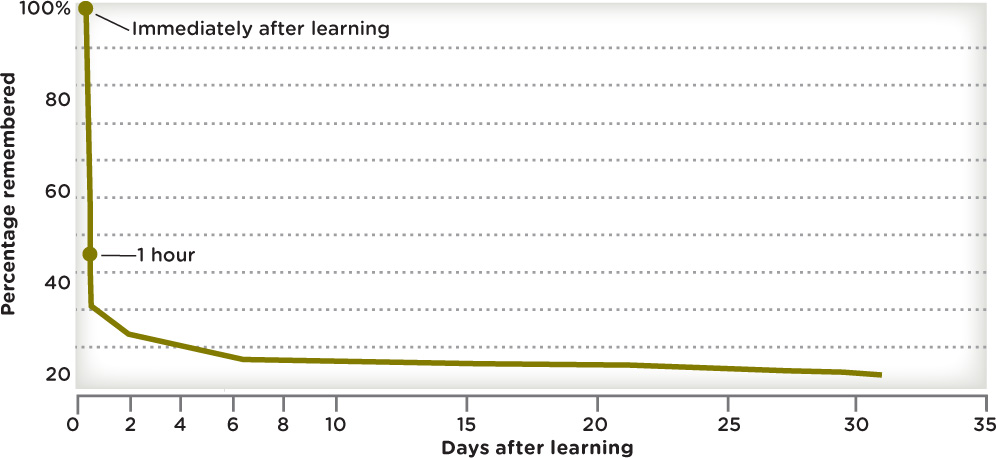
Encoding Failure
What exactly causes us to forget? That may depend on the stage of memory processing—encoding, storage, or retrieval—at which a given instance of memory failure occurs. Sometimes details and events we think we have forgotten were actually never encoded in the first place. Take this example: After a long and stressful day, you stop at the supermarket to pick up a frozen dinner. While fumbling through your bag in search of your wallet, you take out your gloves and place them on the cashier’s counter, but because your attention is focused on finding your wallet, you don’t even notice where you’ve placed the gloves. Then you pay and walk out the door, only to wake up the next morning wondering where you left your gloves! This is an example of encoding failure because the data never entered your memory system. Because you never registered putting your gloves on the counter in the first place, how can you expect to remember where you left them? For a classic demonstration of encoding failure, take a look at the 10 pennies appearing in the Try This feature. You’ve looked at a penny hundreds of times in your life, so identifying the real penny should be no problem, right?
try this
Look at the 10 pennies to the right. Which one is correct?

f
If you’re like most people, chances are you picked the wrong coin because you have never taken the time to study a penny and encode its visual details (Nickerson & Adams, 1979).
Storage Failure and Memory Decay
Memory lapses can also result from storage failure. Take a moment and try to remember your middle school or high school locker combination. The digits may have slipped your mind, but at one point in your life you knew them by heart. The number is inaccessible because you no longer use it; the memory may have decayed over time. However, there is plenty of evidence to suggest that we are capable of storing a vast fund of information, sometimes for a very long time. Such memories might include the name of the street you grew up on (Schmidt et al., 2000), grades in college (Bahrick, Hall, & Da Costa, 2008), and factual knowledge from college courses (Conway, Cohen, & Stanhope, 1991). However, these types of memories are subject to a variety of inaccuracies and distortions, and tapping into them is not always easy.
Tip-of-The-Tongue Phenomenon
Sometimes we know that we have knowledge of something but just can’t pull it out of storage. The name of that college classmate or that new blockbuster movie, it’s just sitting on the tip of your tongue but it won’t slide off! This simple retrieval failure is called the tip-of-the-tongue phenomenon. Most of us have this feeling about once a week, but luckily we are able to retrieve the elusive phrase approximately 50% of the time (James & Burke, 2000; Schwartz, 2012). Often we can correctly guess the first letter of the word or how many syllables it has (Hanley & Chapman, 2008). Studies suggest this tip-of-the-tongue phenomenon becomes more common with age (Brown & Nix, 1996).
Hyperthymestic Syndrome
What would happen if you had the opposite problem—that is, instead of forgetting all the time, you remembered everything? Imagine how overwhelming it would be to remember all the experiences you have had, all the people you have met, the meals that you have eaten over the years, and so on. How would that impact your ability to calculate your grocery bill, remember where you parked your car, and carry out a myriad of other mental tasks required for survival in modern society? Great adaptive value seems to be associated with being able to forget, because it allows you to attend to what’s going on in the here and now. Some people, however, cannot forget. This type of memory ability is known as hyperthymestic syndrome (Parker, Cahill, & McGaugh, 2006). The irony is that having this type of “super” memory has drawbacks, including problems with abstract thinking and the ability to make generalizations, although it doesn’t necessarily impair day-to-day functioning.
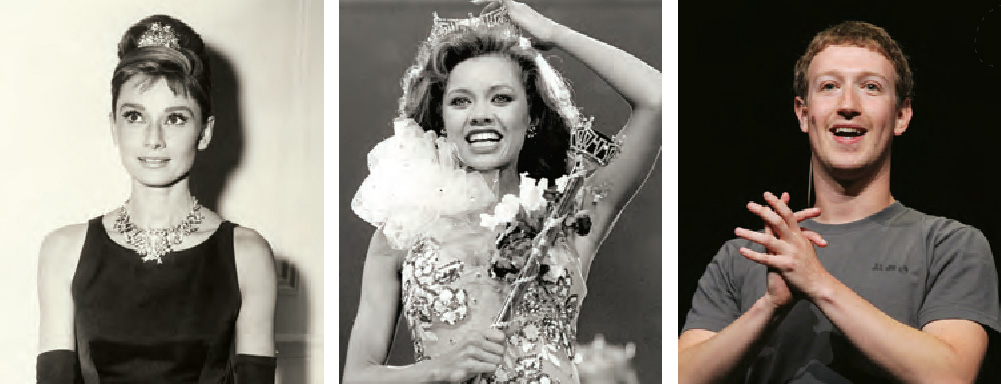
Proactive Interference
You now know that forgetting can stem from problems in encoding and storage. And the tip-of-the-tongue phenomenon tells us that it can also result from glitches in retrieval. Let’s take a closer look at some other retrieval problems. Studies show that retrieval is influenced, or in some cases blocked, by information we learn before and after a memory was made, which we refer to as interference (Waugh & Norman, 1965). If you have studied more than one foreign language, you have probably experienced interference. Suppose you take Spanish in middle school, and then begin studying Italian in college. As you try to learn Italian, you may find Spanish words creeping into your mind and confusing you; this is an example of proactive interference, the tendency for information learned in the past to interfere with the retrieval of new material. People who learn to play a second musical instrument experience the same problem; the fingering of the old instrument interferes with the retrieval of new fingering.
Retroactive Interference
Now let’s say you are going on a trip to Mexico and need to use the Spanish you learned back in middle school. As you approach a vendor in an outdoor market in Costa Maya, you may become frustrated when the only words that come to mind are ciao bello and buongiorno (Italian for “hello handsome” and “good day”), when you really are searching for phrases with the same meaning in Español. Here, recently learned information interferes with the retrieval of things learned in the past. We call this retroactive interference. This type of interference can also impact the musician; when she switches back to her original instrument, the fingering techniques she uses to play the new instrument interfere with her old techniques. Thus, proactive interference results from knowledge acquired in the past and retroactive interference is caused by information learned recently (Figure 6.11).
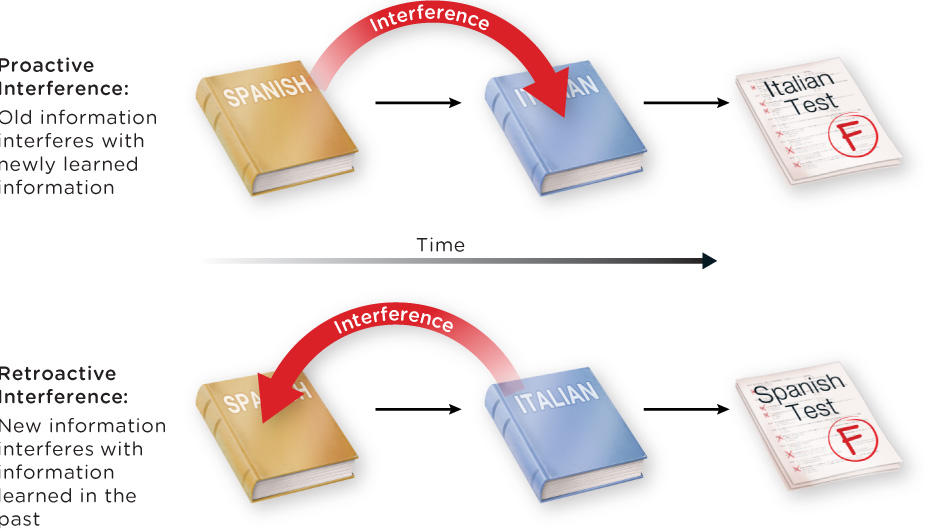
Although our memories fail us all the time, we manage to get by with a little help from our friends, who remind us to set our alarm clocks, study for tests, and say “happy birthday” to so and so. We have cell phones to store phone numbers and e-mail accounts to maintain addresses. Newspapers and television remind us what day it is. And then of course, there is Google.
didn’t SEE that coming
Google Brain
 Google. What would life be like without it? Every day, we use Google to find the answers to questions we are too embarrassed to state out loud. It helps us stay abreast of the latest news, provides us with immediate access to the voices and faces of friends, and helps us schedule our lives. Google is, without doubt, one of the modern brain’s greatest helpers. But here’s the question: Is all of Google’s hard work making us lazy?
Google. What would life be like without it? Every day, we use Google to find the answers to questions we are too embarrassed to state out loud. It helps us stay abreast of the latest news, provides us with immediate access to the voices and faces of friends, and helps us schedule our lives. Google is, without doubt, one of the modern brain’s greatest helpers. But here’s the question: Is all of Google’s hard work making us lazy?
Maybe “resourceful” is a better word. A study by Sparrow, Liu, and Wegner (2011) found that people essentially use computers as storage places for information they would otherwise have to remember. In one experiment, the researchers asked participants to read and type 40 statements referring to trivia-like information (for example, “An ostrich’s eye is bigger than its brain”). Those who were told they would need the information later and that it would be available on the computer were less likely to try memorizing it than those denied computer access. Participants who were not asked to remember the information also showed better recall for the trivia if they had no expectations of later searching for it on the computer. And so it seems, we as a culture have adapted to being constantly “plugged in” and having information at our fingertips.
IS GOOGLE MAKING US LAZY?
In the past, people simply memorized new phone numbers or jotted them down in an address book. Now we rely on a few keystrokes and the click of a mouse. Imagine life without our digital sidekicks like Google, Yahoo, and Bing. Remember the last time you lost Internet service? “The experience of losing our Internet connection becomes more and more like losing a friend” (Sparrow et al., 2011, p. 4).
show what you know
Question 6.11
1. __________ suggests that retrieving memories is easier in the context in which they were made.
- The encoding specificity principle
- Retroactive interference
- Proactive interference
- The curve of forgetting
a. The encoding specificity principle
Question 6.12
2. Your friend remarks that her scores are better when she studies and takes her quiz in Starbucks than if she studies in Starbucks but takes the quiz at home. She is exhibiting:
- context-dependent memory.
- proactive interference.
- retroactive interference.
- mood-congruency of memory.
a. context-dependent memory.
Question 6.13
3. Ebbinghaus reported that his memory of word lists plunged the first hour after he learned them; he displayed this in his:
- encoding specificity principle.
- curve of forgetting.
- recency effect.
- serial position effect.
b. curve of forgetting.
Question 6.14
4. Imagine a friend is almost finished with her application for a job she really wants. Create two arguments for when she should submit her application using what you know about the serial position effect (applications are being accepted for a seven day period): one based on the primacy effect the other on the recency effect.
Your friend should submit her application on the first day, because the primacy effect suggests her application will be better remembered than those in the middle of the week. It is likely that the first applications submitted will be encoded into the long-term memories of the people on the hiring committee.
Or, if she is not ready to send her application on the first day, you should encourage her to send her application so that it arrives on the seventh day. The recency effect suggests her application will be better remembered than those from the middle of the week, because it will linger somewhat in short-term memory (though not necessarily transition to long-term storage).